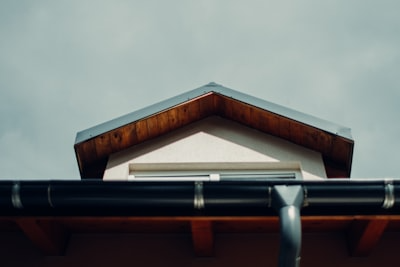Deciding what size gutters do I need is more than a casual home improvement task; it’s a crucial decision to safeguard your property. Picking out just the right gutter size might not seem like a big deal at first glance, but trust me, it’s crucial for steering clear of unwanted water around your house. Exploring how the slope of your roof and regional climate conditions are key in selecting gutters that can handle intense rainfall is what you’ll grasp here. Deciding between a K-style gutter and its more rounded cousin for your place? Each has its own charm and fits certain house types better – let’s sort that out together so you can pick wisely.
Understanding Gutter Sizes and Their Importance
The Role of Gutter Size in Home Maintenance
Gutters might not be the most glamorous part of your house, but they’re certainly one of the unsung heroes. Deciding on the right size for your gutters is key to dodging water damage and making sure rainwater gets redirected properly. The last thing anyone wants is a mini Niagara Falls pouring over their gutters during a heavy downpour.
So, what’s the deal with standard gutter sizes? Typically, we see 5 inches and 6 inches as the go-to choices for homeowners across Northeast Ohio. These sizes aren’t just random numbers; they are carefully chosen to match different rainfall intensities effectively.
To get more insight into why these specific dimensions matter, you can check out resources from SMACNA. They provide an abundance of information on effective water management that could save your home from unwanted moisture issues.
Factors to Consider When Choosing Gutter Size
When it comes time to pick your gutters’ size, there’s more at play than just grabbing a tape measure and hoping for the best. You need to consider things like roof pitch and local climate conditions—because let’s face it: Not all roofs or weather patterns are created equal.
A steeper roof will send water barreling towards your gutters faster than you can say “umbrella,” requiring wider channels to handle that rush without overflowing. Similarly, if you live in an area prone to monsoon-like rains rather than gentle showers, bigger may indeed be better when it comes to gutter sizing.
Factors to Consider When Choosing Gutter Size

How Roof Pitch Influences Your Choice
The slope of your roof, or its pitch, plays a huge role in picking the right gutter size. Steep roofs send water barreling down like racecars on a track, needing wider gutters to catch all that runoff. On the flip side, more gently sloped roofs can get by with smaller sizes since water travels more leisurely down them.
The Sheet Metal and Air Conditioning Contractors’ National Association (SMACNA) guidelines suggest considering both roof pitch and local maximum rainfall intensity when deciding on gutter dimensions. This is because steeper pitches increase the speed at which rainwater is delivered to your gutters.
Climate’s Role in Gutter Sizing Decisions
Your local weather bureau probably has some interesting stats about how much it rains where you live – this info is gold when choosing gutter size. Areas prone to heavy downpour need bigger gutters and possibly extra downspouts to prevent overflow that could lead to water damage around your home’s foundation.
In regions with less intense rainfall but frequent storms, standard-sized gutters might do just fine if they’re properly maintained and equipped with efficient gutter guards. However, erring on the side of caution with slightly larger than necessary sizes can save headaches during unexpected weather extremes.
Popular Types of Gutters and Their Dimensions
K-Style Gutters – A Popular Choice for Modern Homes
When it comes to managing rainwater, you can’t go wrong with K-style gutters. Merging practicality with an aesthetic reminiscent of crown molding, these gutters enhance a home’s exterior effortlessly. Most residential homes find the five-inch K-style gutters perfectly suited for their needs. But here’s the kicker: in areas prone to heavy downpours, six-inch versions step up as the heroes, providing extra capacity to handle more water.
The appeal of K-style gutters isn’t just about looks or functionality; it’s also about variety. Whether your home sports aluminum, copper, or seamless styles, there’s a fit for every aesthetic and budget.
Half-Round Gutters – Classic Elegance with Effective Water Management
If you’re all about giving your home a touch of timeless elegance while keeping your feet dry, half-round gutters are where it’s at. Known for their smooth shape that efficiently moves water away from your home, these bad boys come mainly in six-inch sizes for residential properties.
This gutter style isn’t just easy on the eyes; its design minimizes clogs and makes cleaning less of a hassle—a win-win if ever there was one. With options available in various materials like aluminum or copper, you can match them seamlessly with any architectural style without sacrificing performance during those unexpected heavy rains.
Calculating Your Home’s Gutter Needs Accurately
To nail down the optimal gutter sizing for your home, understanding how to calculate square footage and adjust it is key. But there’s more to this equation than just raw numbers.
Adjusting for Pitch and Rainfall
First off, grab a tape measure because you’ll need to know your roof’s total square footage. Then, things get interesting when we bring in the pitch factor and rainfall intensity into play. It turns out that not all square feet are created equal—at least when it comes to gutters.
If your roof has multiple facets or steep angles (think hip roofs or intersecting designs), these can significantly affect water flow during heavy downpours. By multiplying the drainage area by both the roof-pitch factor and maximum rainfall intensity from local weather bureau data, you’ll get what’s called adjusted square footage—a number far more accurate for picking out those perfect gutters.
This calculation might sound like rocket science at first glance but fear not; resources like SMACNA guidelines exist exactly for moments like these—turning complex calculations into actionable insights so you don’t end up with clogged gutters after every storm. Remember: if different areas of your roof suggest different sizes based on their unique drainage needs, always go with the bigger option—it’s better safe than sorry.
FAQs in Relation to What Size Gutters Do I Need
Are 5 or 6 inch gutters better?
It depends on your roof’s size and local rainfall. Five-inch gutters suit most homes, but pick six inches for heavy downpours.
Should I get 6 or 7 inch gutters?
Six-inch gutters work well for most residential needs. Go for seven inches if you’re in a high rainfall area with a large roof.
What size are most residential gutters?
The majority of houses rock five-inch K-style or six-inch half-rounds, perfect for handling the average rain volume.
What size guttering should I use?
Your choice hinges on roof pitch and rainfall rates. Measure up then decide; when in doubt, bigger handles more water.
Conclusion
You’ve learned that roof pitch and local weather are key players in this decision. Remember, choosing right can prevent costly water damage.
Understanding K-style and half-round gutters means knowing your home’s needs and aesthetic appeal. Calculating adjusted square footage is not just a step; it’s your path to precision.
Picking gutter sizes isn’t guesswork. It’s about smart choices based on clear factors. Consider all the components we’ve covered, ranging from weather patterns to architectural nuances of your rooftop.
In the end, armed with knowledge on dimensions and styles, you’re now set to enhance both function and form of your home’s exterior. So let this guide be your blueprint as you navigate through the rains ahead.
Still have questions? Check out our Residential Services page to learn more about our gutter installation process.



